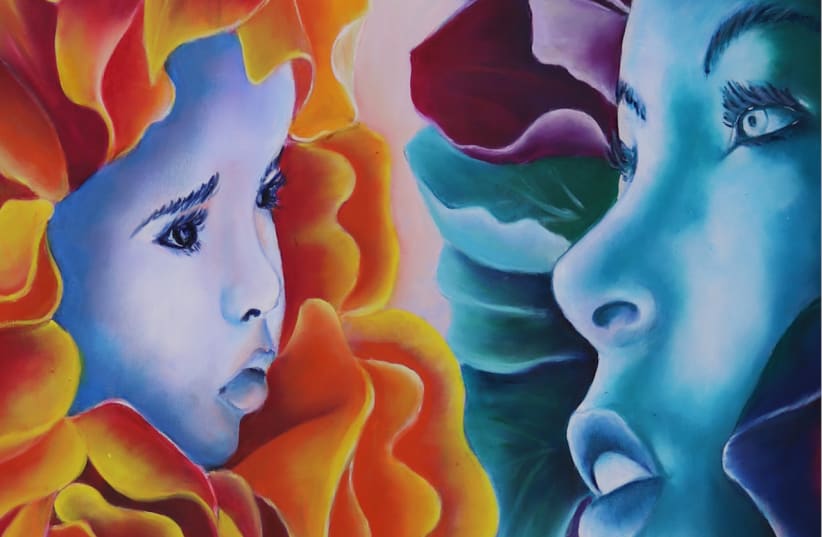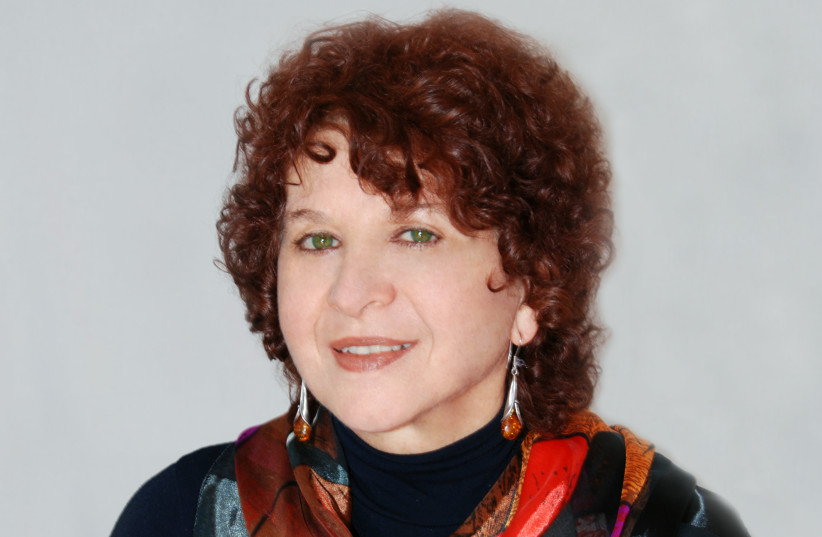Perched in a chair in her studio in Mevaseret Zion, surrounded by colorful canvases soon to be sent to a Tel Aviv studio that will be sponsoring a solo exhibition of her work, Sagi Erez is the picture of contentment.
Erez was born into an 11th-generation Jerusalem family and grew up with her siblings in a small apartment in Jerusalem’s Mekor Baruch neighborhood before moving to a larger home in the capital’s Yefeh Nof, built by her father, a contractor.
“I had a beautiful childhood,” she recalls with a nostalgic smile. “We were the only building there until they started to build Yefeh Nof. All the children would play outside, and when evening came, all the mothers called out our names to come home.” She pauses for a moment, and then adds, “Though when I think about it, we were poor, but we didn’t feel it.”
“We were the only building there until they started to build Yefeh Nof. All the children would play outside, and when evening came, all the mothers called out our names to come home. Though when I think about it, we were poor, but we didn’t feel it.”
Sagi Erez
A beautiful childhood, leaving Israel and returning
Growing up, Erez – whose first name is actually Siglia, which derives from the Hebrew term for “violet” – was always interested in art and routinely received A’s in school for her artistic projects. After completing her IDF service in the Military Police, she married Ran Vas and moved to Haifa, where Vas completed his PhD studies at the Technion-Israel Institute of Technology in medical engineering.
Soon after he completed his degree, the couple began to travel abroad for her husband’s work. The first stop was Holland. Sagi and Ran lived in Eindhoven, the fifth-largest city in the Netherlands, and Utrecht, where Erez continued her art studies.
They then returned to Haifa, and Erez studied art in the Technion’s Art Department. At that time, she began to give private art lessons. Soon, they were on the move again, this time to Scotland, where she earned her first degree (diploma of art) from the Glasgow School of Art during their three-year sojourn.
Sagi gave birth to two children, Elior and Danit, who accompanied their parents throughout their travels.
The next stop for the peripatetic family was Pittsburgh, Pennsylvania, home of Carnegie Mellon University, where her husband had been invited. Erez studied art history at the university. While she was not enamored of Pittsburgh, she had a far more favorable impression of Carnegie Mellon and calls it “a wonderful place.”
From Pennsylvania, the family moved on to Los Angeles, as Ran was working at Cedars-Sinai Medical Center. Erez attended California State University at Northridge, finishing her BA degree and obtaining a master’s degree in art, while teaching students in her art studio.
In 1990, she and Ran divorced, but in 1994 she met and married Shmuel Erez, an Israeli working in hi-tech who was in the US on a three-month project. In 1995, the couple moved to San Jose, in the heart of Silicon Valley, and she opened her art studio there, where she taught art to children and adults.
Due to the international hi-tech scene in Silicon Valley, she had many students who were not US-born, including many engineers.
“I already knew how to work with engineers because I married two,” she quips. “When you teach art to engineers, you have to tell them that it is okay to make mistakes in art.” In their line of work, she explains, there is little allowance for making a structural error in a bridge or building. “I taught them how to make mistakes.”
Her students in San Jose hailed from a wide variety of countries, such as India, the Philippines, South Korea, Australia, China and France. She attuned herself to their varying cultural backgrounds to help them in their artistic development.
“For instance,” she explains, “many of my Indian students initially painted pictures of their gods. I had to learn about them because that was the way we could use colors and make the composition. I learned a lot about the Hindu religion.”
Some students, she says, came to class with cultural constraints that hampered their creativity. Many of her Chinese and Japanese students would slavishly copy pictures instead of creating original art.
“I had a Japanese student who was always copying designs, and I saw how wonderful he was. I said, ‘Why don’t you paint something different?’ He said, ‘I’m scared.’ I said, ‘Try,’ and he did. He produced a beautiful oil painting.”
The student explained, “In our Japanese culture, I was raised with a father who did not allow crying or laughter. You have to understand how handicapped we are.”
Erez also had a number of Israeli students, and she says they brought creativity into her studio. The class was a mix of beginners and advanced students, and she told her students, “Don’t be afraid because if you work with advanced students, you will advance much faster.”
In addition to teaching art techniques, she also taught her students about the history of art and how art was occasionally used for political purposes, both negative and positive. In that context, she confessed to her students that she wanted to use her art to make a positive statement but had not succeeded.
One of her Chinese students stood up and said, “You did succeed. We are 14 people in your class, and everyone comes from another country. We are sitting with a Jewish woman from Israel who is teaching us about her art – and you are telling us that you didn’t succeed in politics?! We have all learned about the Jewish people from you.”
She recalls, “I cried, and they all hugged me.”
Throughout Erez’s Diaspora travels, she remained in touch with her family in Israel and visited frequently. During her visits to Israel, her mother would invite family members to come and see her Sat her mother’s home. Her entire family lived in Jerusalem, and, she jokes, “I was the only one who betrayed them.”
Her two children preceded their mother in returning to Israel. Danit moved to Israel in 1997, and Elior in 2007.
The children were not raised in an Orthodox Jewish home but became observant after returning to Israel, beginning with Danit, when she spent her junior year in Israel. The same pattern repeated itself when Elior went to Israel.
Elior graduated from medical school in the United States before returning to Israel, and Danit received her master’s degree in art in the US as well.
EREZ AND her husband returned to Israel in 2017. She says she never wanted to remain in the United States permanently, and she agreed to marry Shmuel only if he promised to return to Israel.
“One day,” she recalls, “we said, ‘that’s it.’ We sold the house in one weekend.”
The couple returned to Israel three months after Erez sold her art studio and moved to Mevaseret Zion. Today, she paints and gives art classes in her studio, adjacent to her home. Her art has been exhibited in England, Scotland, Korea, Canada and the United States.
While her extended family lives in Jerusalem, her children live with their families in Telz-Stone, an Orthodox community located 10 kilometers west of Jerusalem.
Says Erez, “They decided they loved Judaism. I am very proud of them.”
Elior is a psychiatrist; and Danit, an artist and psychologist, is one of the authors of the “Three Ladies – Three Lattes” column that appears in The Jerusalem Post Magazine.
Sagi and Shmuel chose to live in Mevaseret due to its proximity to Telz-Stone. Every Friday morning, Erez prepares ingredients for salads – her kitchen in Mevaseret is strictly kosher – and drives to her daughter’s home and prepares food for Shabbat, together with her daughter, before returning to Mevaseret.
On Friday afternoons, she and Shmuel return to Telz-Stone, park their car near the bottom of the hill, and spend Shabbat evening with their children and 13 grandchildren, beginning at their son and daughter-in-law’s home and then visiting their daughter and son-in-law. When their Friday evening visit has concluded, the family walks them to their car, and Sagi and Shmuel drive home to Mevaseret.
“I respect them, and they respect me,” she says. “They know I am not religious, but they respect me for my life, and I respect them for what they chose.”
Erez is delighted to be back in Israel. Since returning home, she says, her artwork has taken on a more colorful dimension.
“I feel kisses from my own country,” she says. “Israel embraced me to return.”■
Sagi Erez’s work is appearing in ‘Illusion,’ a solo exhibition at the Tribal Art & Israeli Art Gallery, 13 Merkaz Ba’alei Melacha Street, Tel Aviv, until February 11.
SAGI EREZ FROM SAN JOSE, CALIFORNIA, TO MEVASERET ZION, 2017

